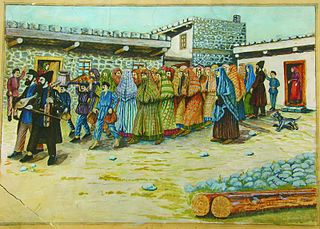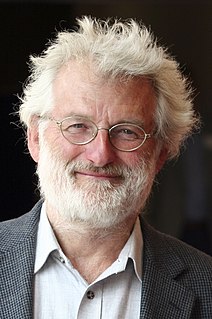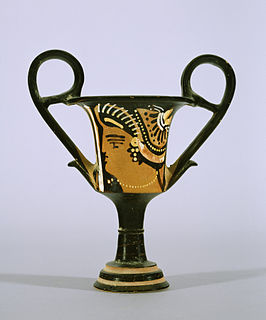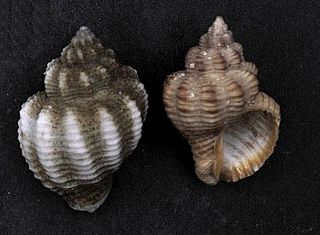Related Research Articles

Caenorhabditis elegans is a free-living transparent nematode about 1 mm in length that lives in temperate soil environments. It is the type species of its genus. The name is a blend of the Greek caeno- (recent), rhabditis (rod-like) and Latin elegans (elegant). In 1900, Maupas initially named it Rhabditides elegans. Osche placed it in the subgenus Caenorhabditis in 1952, and in 1955, Dougherty raised Caenorhabditis to the status of genus.

Ritual purification is the ritual prescribed by a religion by which a person is considered to be free of uncleanliness, especially prior to the worship of a deity, and ritual purity is a state of ritual cleanliness. Ritual purification may also apply to objects and places. Ritual uncleanliness is not identical with ordinary physical impurity, such as dirt stains; nevertheless, body fluids are generally considered ritually unclean.
Howard Robert Horvitz is an American biologist best known for his research on the nematode worm Caenorhabditis elegans, for which he was awarded the 2002 Nobel Prize in Physiology or Medicine, together with Sydney Brenner and John E. Sulston, whose "seminal discoveries concerning the genetic regulation of organ development and programmed cell death" were "important for medical research and have shed new light on the pathogenesis of many diseases".

Sir John Edward Sulston was a British biologist and academic who won the Nobel Prize in Physiology or Medicine for his work on the cell lineage and genome of the worm Caenorhabditis elegans in 2002 with his colleagues Sydney Brenner and Robert Horvitz. He was a leader in human genome research and Chair of the Institute for Science, Ethics and Innovation at the University of Manchester. Sulston was in favour of science in the public interest, such as free public access of scientific information and against the patenting of genes and the privatisation of genetic technologies.

A kantharos or cantharus is a type of ancient Greek cup used for drinking. Although almost all surviving examples are in Greek pottery, the shape, like many Greek vessel types, probably originates in metalwork. In its iconic "Type A" form, it is characterized by its deep bowl, tall pedestal foot, and pair of high-swung handles which extend above the lip of the pot. The Greek words kotylos and kotyle are other ancient names for this same shape.

The Wyoming ground squirrel is a species of rodent in the family Sciuridae.

The elegant water shrew is a species of mammal in the subfamily Soricinae of the family Soricidae. It is monotypic within the genus Nectogale. It lives in Sikkim and China.

The black seabream is a species of Sparidae fishes. They are recognisable by their oval compressed body and jaws containing 4-6 rows of slender teeth which are larger at the front. They are silvery in colour with blue and pink tinges and broken longitudinal gold lines. They can reach a maximum size of 60 cm in length. They live in northern Europe and in the Mediterranean, usually found on the inshore shelf at depths varying from 5 to 300 m. They are usually found in schools feeding on seaweeds and invertebrates. They breed in February to May leaving eggs in the demersal zone.
Alexis was an ancient Greek sculptor mentioned by Pliny as one of the pupils of Polykleitos. Pausanias mentions an artist of the same name, a native of Sicyon, and father of the sculptor Cantharus. It cannot be satisfactorily settled whether these are the same, or different persons. Pliny's account implies that he had the elder Polykleitos in mind, in which case Alexis could not have flourished later than Olympiad 95 in 400 BC, whereas Eutychides, under whom Cantharus studied, flourished about Olympiad 120 in 300. If the two were identical, as German classicist Friedrich Thiersch thinks, we must suppose either that Pliny made a mistake, and that Alexis studied instead under Polykleitos the Younger, or else that Eutychides, whose date is given by Pliny, was not the artist under whom Cantharus studied.

Water is considered a purifier in most religions.

Cantharus tranquebaricus, common name the Tranquebar goblet, is a species of sea snail, a marine gastropod mollusk in the family Pisaniidae, the true whelks.

Gemophos auritulus, the common cantharus or gaudy cantharus, is a species of sea snail in the family Pisaniidae.

Gemophos tinctus, the tinted cantharus, painted cantharus, or gaudy lesser whelk, is a species of sea snail in the family Pisaniidae.
Hesperisternia multangula, the ribbed cantharus, is a species of sea snail in the family Pisaniidae. The ribbed cantharus was first formally named by Rodolfo Amando Philippi in 1848 as Fusus multangulus. The type locality is from the Yucatán Peninsula.

Cantharus is a genus of sea snails in the family Pisaniidae.
In molecular biology mir-84 microRNA is a short RNA molecule. MicroRNAs function to regulate the expression levels of other genes by several mechanisms.

Bauruemys is an extinct genus of turtles in the family Podocnemididae.

A cantharus, also known as a phiala, is a fountain used by Christians for ablution before entering a church. These ablutions involve the washing of the hands, face, and feet. The cantharus is traditionally located in the exonarthex of the church. The water emitted by a cantharus is to be running water. The practice of ablutions before prayer and worship in Christianity symbolizes "separation form sins of the spirit and surrender to the Lord." Eusebius recorded this practice of canthari located in the courtyards of churches, for the faithful to wash themselves before entering a Christian house of worship. The practice has its origins Jewish practice of performing ablutions before entering into the presence of God. Though canthari are not as prevalent anymore in Western Christianity, they are found in Eastern Christian and Oriental Christian churches.
Cantharus may refer to:
References
- ↑ The Mollusca and Radiata. E Griffith and E Pidgeon - Arranged by the Baron Cuvier, with supplementary additions to each orders. 1834